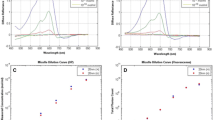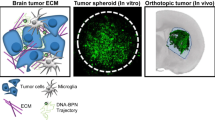Abstract
The cell-penetrating trans-activator of transcription (TAT) is a cationic peptide derived from human immunodeficiency virus-1. It has been used to facilitate macromolecule delivery to various cell types. This cationic peptide is capable of crossing the blood–brain barrier and therefore might be useful for enhancing the delivery of drugs that target brain tumors. Here we test the efficiency with which relatively small (20 nm) micelles can be delivered by an intra-arterial route specifically to gliomas. Utilizing the well-established method of flow-arrest intra-arterial injection we compared the degree of brain tumor deposition of cationic TAT-decorated micelles versus neutral micelles. Our in vivo and post-mortem analyses confirm glioma-specific deposition of both TAT-decorated and neutral micelles. Increased tumor deposition conferred by the positive charge on the TAT-decorated micelles was modest. Computational modeling suggested a decreased relevance of particle charge at the small sizes tested but not for larger particles. We conclude that continued optimization of micelles may represent a viable strategy for targeting brain tumors after intra-arterial injection. Particle size and charge are important to consider during the directed development of nanoparticles for intra-arterial delivery to brain tumors.



Similar content being viewed by others
References
Ellis JA, Banu M, Hossain SS, Singh-Moon R, Lavine SD, Bruce JN, Joshi S (2015) Reassessing the role of intra-arterial drug delivery for glioblastoma multiforme treatment. J Drug Deliv 2015:405735. doi:10.1155/2015/405735
Joshi S, Ellis JA, Ornstein E, Bruce JN (2015) Intraarterial drug delivery for glioblastoma mutiforme: will the phoenix rise again? J Neurooncol 124(3):333–343. doi:10.1007/s11060-015-1846-6
Riina HA, Knopman J, Greenfield JP, Fralin S, Gobin YP, Tsiouris AJ, Souweidane MM, Boockvar JA (2010) Balloon-assisted superselective intra-arterial cerebral infusion of bevacizumab for malignant brainstem glioma. A technical note. Interv Neuroradiol 16(1):71–76
Hashimoto T, Young WL, Aagaard BD, Joshi S, Ostapkovich ND, Pile-Spellman J (2000) Adenosine-induced ventricular asystole to induce transient profound systemic hypotension in patients undergoing endovascular therapy. Dose-response characteristics. Anesthesiology 93(4):998–1001
Pile-Spellman J, Young WL, Joshi S, Duong DH, Vang MC, Hartmann A, Kahn RA, Rubin DA, Prestigiacomo CJ, Ostapkovich ND (1999) Adenosine-induced cardiac pause for endovascular embolization of cerebral arteriovenous malformations: technical case report. Neurosurgery 44(4):881–886 (discussion 886–887)
Joshi S, Wang M, Etu JJ, Suckow RF, Cooper TB, Feinmark SJ, Bruce JN, Fine RL (2008) Transient cerebral hypoperfusion enhances intraarterial carmustine deposition into brain tissue. J Neurooncol 86(2):123–132. doi:10.1007/s11060-007-9450-z
Joshi S, Singh-Moon RP, Wang M, Chaudhuri DB, Holcomb M, Straubinger NL, Bruce JN, Bigio IJ, Straubinger RM (2014) Transient cerebral hypoperfusion assisted intraarterial cationic liposome delivery to brain tissue. J Neurooncol 118(1):73–82. doi:10.1007/s11060-014-1421-6
Wang M, Etu J, Joshi S (2007) Enhanced disruption of the blood brain barrier by intracarotid mannitol injection during transient cerebral hypoperfusion in rabbits. J Neurosurg Anesthesiol 19(4):249–256. doi:10.1097/ANA.0b013e3181453851
Joshi S, Cooke JR, Chan DK, Ellis JA, Hossain SS, Singh-Moon RP, Wang M, Bigio IJ, Bruce JN, Straubinger RM (2016) Liposome size and charge optimization for intraarterial delivery to gliomas. Drug Deliv Transl Res 6(3):225–233. doi:10.1007/s13346-016-0294-y
Nguyen J, Sievers R, Motion JP, Kivimae S, Fang Q, Lee RJ (2015) Delivery of lipid micelles into infarcted myocardium using a lipid-linked matrix metalloproteinase targeting peptide. Mol Pharm 12(4):1150–1157. doi:10.1021/mp500653y
Walsh CL, Nguyen J, Szoka FC (2012) Synthesis and characterization of novel zwitterionic lipids with pH-responsive biophysical properties. Chem Commun 48(45):5575–5577. doi:10.1039/c2cc31710a
Bigio IJ, Bown SG (2004) Spectroscopic sensing of cancer and cancer therapy: current status of translational research. Cancer Biol Ther 3(3):259–267
Mourant JR, Johnson TM, Los G, Bigio IJ (1999) Non-invasive measurement of chemotherapy drug concentrations in tissue: preliminary demonstrations of in vivo measurements. Phys Med Biol 44(5):1397–1417
Reif R, Wang M, Joshi S, A’Amar O, Bigio IJ (2007) Optical method for real-time monitoring of drug concentrations facilitates the development of novel methods for drug delivery to brain tissue. J Biomed Opt 12(3):034036
Ergin A, Wang M, Zhang J, Bigio I, Joshi S (2012) Noninvasive in vivo optical assessment of blood brain barrier permeability and brain tissue drug deposition in rabbits. J Biomed Opt 17(5):057008
Wilkins DE, Raaphorst GP, Saunders JK, Sutherland GR, Smith IC (1995) Correlation between Gd-enhanced MR imaging and histopathology in treated and untreated 9L rat brain tumors. Magn Reson Imaging 13(1):89–96
Fross RD, Warnke PC, Groothuis DR (1991) Blood flow and blood-to-tissue transport in 9L gliosarcomas: the role of the brain tumor model in drug delivery research. J Neurooncol 11(3):185–197
Barth RF, Kaur B (2009) Rat brain tumor models in experimental neuro-oncology: the C6, 9L, T9, RG2, F98, BT4C, RT-2 and CNS-1 gliomas. J Neurooncol 94(3):299–312. doi:10.1007/s11060-009-9875-7
Hossain SS, Hossainy SFA, Bazilevs Y, Calo VM, Hughes TJR (2012) Mathematical modeling of coupled drug and drug-encapsulated nanoparticle transport in patient-specific coronary artery walls. Comput Mech 49(2):213–242
Hossain SS, Zhang Y, Liang X, Hussain F, Ferrari M, Hughes TJ, Decuzzi P (2013) In silico vascular modeling for personalized nanoparticle delivery. Nanomedicine 8(3):343–357. doi:10.2217/nnm.12.124
Hossain SS, Hughes TJ, Decuzzi P (2014) Vascular deposition patterns for nanoparticles in an inflamed patient-specific arterial tree. Biomech Model Mechanobiol 13(3):585–597. doi:10.1007/s10237-013-0520-1
Joshi S, Singh-Moon R, Wang M, Chaudhuri DB, Ellis JA, Bruce JN, Bigio IJ, Straubinger RM (2014) Cationic surface charge enhances early regional deposition of liposomes after intracarotid injection. J Neurooncol 120(3):489–497. doi:10.1007/s11060-014-1584-1
Joshi S, Singh-Moon RP, Ellis JA, Chaudhuri DB, Wang M, Reif R, Bruce JN, Bigio IJ, Straubinger RM (2015) Cerebral hypoperfusion-assisted intra-arterial deposition of liposomes in normal and glioma-bearing rats. Neurosurgery 76(1):92–100. doi:10.1227/NEU.0000000000000552
Joshi S, Ellis JA, Emala CW (2014) Revisiting intra-arterial drug delivery for treating brain diseases or is it “deja-vu, all over again”? J Neuroanaesth Crit Care 1(2):108–115. doi:10.4103/2348-0548.130386
Cooke JN, Hossain S, Ellis JE, Joshi S (2016) Limitations of intraarterial drug delivery without optimized formulations revealed by pharmacokinetic modeling (Abstract, accepted for the Proceedings of Society of Neuroanesthesiology and Critical Care 44th Annual Meeting, Chicago IL). J Neurosurg Anesthesiol 28(4):493–494
Dedrick RL (1988) Arterial drug infusion: pharmacokinetic problems and pitfalls. J Natl Cancer Inst 80(2):84–89
Cooke JN, Ellis JA, Hossain S, Nguyen J, Bruce JN, Joshi S (2016) Computational pharmacokinetic rationale for intra-arterial delivery to the brain. Drug Deliv Transl Res 6(5):622–629. doi:10.1007/s13346-016-0319-6
Kang T, Zhu Q, Jiang D, Feng X, Feng J, Jiang T, Yao J, Jing Y, Song Q, Jiang X, Gao X, Chen J (2016) Synergistic targeting tenascin C and neuropilin-1 for specific penetration of nanoparticles for anti-glioblastoma treatment. Biomaterials 101:60–75. doi:10.1016/j.biomaterials.2016.05.037
Munson JM, Bellamkonda RV, Swartz MA (2013) Interstitial flow in a 3D microenvironment increases glioma invasion by a CXCR4-dependent mechanism. Cancer Res 73(5):1536–1546. doi:10.1158/0008-5472.CAN-12-2838
Madani F, Lindberg S, Langel U, Futaki S, Graslund A (2011) Mechanisms of cellular uptake of cell-penetrating peptides. Journal Biophys 2011:414729. doi:10.1155/2011/414729
Joshi S, Wang M, Singh-Moon R (2013) Feasibility of intra-arterial drug delivery to brain tissue using cell penetrating peptides. J Neurosurg Anesthesiol 25(4):465. doi:10.1097/ANA.0b013e3182a4d5ff
Lohcharoenkal W, Manosaroi A, Gotz F, Werner RG, Manosroi W, Manosaroi J (2011) Potent enhancement of GFP uptake into HT-29 cells and rat skin permeation by coincubation with tat peptide. J Pharm Sci 100(11):4766–4773. doi:10.1002/jps.22671
Funding
National Cancer Institute at the National Institutes of Health RO1-CA-138643.
Author information
Authors and Affiliations
Corresponding author
Ethics declarations
Conflict of interest
The authors declare that they have no conflict of interest.
Ethical approval
All applicable international, national, and/or institutional guidelines for the care and use of animals were followed. All procedures performed were in accordance with the ethical standards of Columbia University.
Rights and permissions
About this article
Cite this article
Nguyen, J., Hossain, S.S., Cooke, J.R.N. et al. Flow arrest intra-arterial delivery of small TAT-decorated and neutral micelles to gliomas. J Neurooncol 133, 77–85 (2017). https://doi.org/10.1007/s11060-017-2429-5
Received:
Accepted:
Published:
Issue Date:
DOI: https://doi.org/10.1007/s11060-017-2429-5




